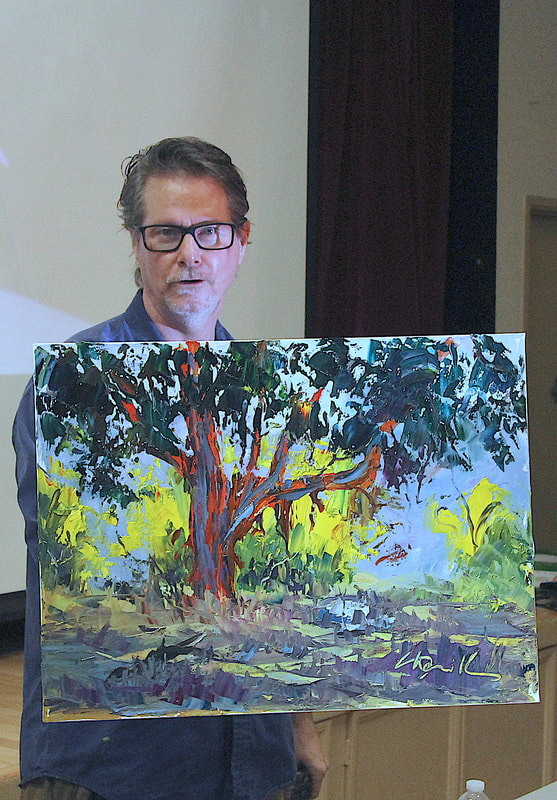Robert Sherrill demonstration - September 6
|
Robert Sherril gave us a fun and lively demo with his palette knife. To begin he talked about scouting out for ideas and inspiration. He takes a sketchbook or uses a camera and takes lots of photographs (to easily frame a composition and get quick ideas). Sherrill’s sketchbook is filled with quick, small thumbnails that examine composition and rhythm. Usually black and white with minimal gray scales, the drawings can be sketched by marker or gouache, but are left loose and abstract to help find what is interesting in a piece. Sherrill encourages the artist to paint what interests them using their own ideas and opinions about things. He emphasizes the importance of shape, value and color. Sherrill uses large palette knives and enjoys painting about color and texture. He does not overwork his paintings with detail but rather gives basic shapes enough detail to get a layout of where the artwork is going. He holds his palette knife very loosely to keep the painting loose. To begin his demonstration he quickly painted a 5”x7” gray scale composition as a roadmap to guide his colored painting. Before starting a painting, he suggests making a light grid as “the Rule of Thirds” to help make an interesting composition and make sure the focal point was not directly in the center of the painting. He put his main focus, a tree, off to the left one-third of the canvas, and then worked with three values: white, mid tone and dark. The tree (focal point) used the mid value, while his dark shadows came forward and the bushes behind the tree were white to help make the tree pop. Sherrill started his color painting with the sky. He put down white and blue andmixed right on the canvas. He then added a tiny smidge of red and lemon yellow in various places in the sky. These colors are mixed right on the canvas and create a variation of blues in the sky, and sometimes create happy accidents that give a great look or mood. Sherrill doesn’t mix too much or else the color will get grey. He saturated his tree to bring it closer while painting the background bushes blue grey to recede back. At first, he painted in a thin layer to leave room on the canvas to add more paint. |
Throughout his demonstration, Sherrill continued to build on his painting by adding the giant tree, foliage, and leaving white spaces in the foreground shadow to let the light shine throughout the trees. He then grounded his tree by delicately bringing foliage and dead grass up and overlapping various bushes and rocks. He added small twigs, hanging branches and baby trees sprouting near the main tree. He might consider adding silhouetted objects to help lead the eye and help enhance the main tree.Sherrill began with shape and value, moved to color and finished with bringing about emotion to the edges. Sherrill knows his paintings are complete when he gets working on the edges. He creatively brings his paintings to life with light and color. The backlight of the vibrant bush illuminated the tree. The heavy foreground shadow over the dead grass, the rocks, and twigs helped create a depth in this nature scene. Sherrill’s demonstration was inspiring and insightful.
Sherrill teaches classes at the Creative Arts Group, The Huntington Library and Art Center.
Sherrill teaches classes at the Creative Arts Group, The Huntington Library and Art Center.

